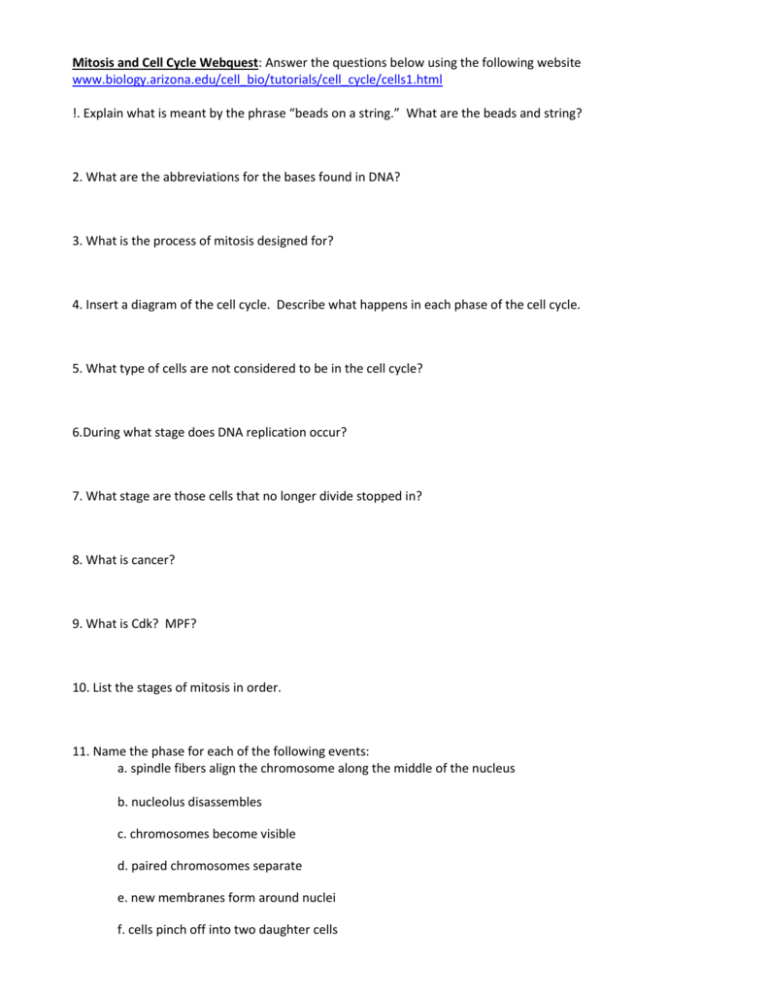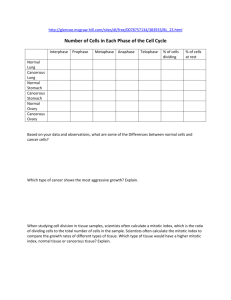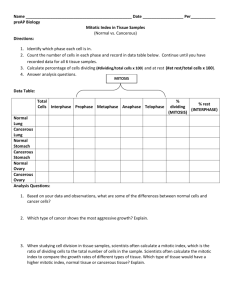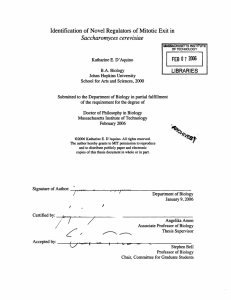Webquest Cell Cycle Mitosis and Cancer
advertisement

Mitosis and Cell Cycle Webquest: Answer the questions below using the following website www.biology.arizona.edu/cell_bio/tutorials/cell_cycle/cells1.html !. Explain what is meant by the phrase “beads on a string.” What are the beads and string? 2. What are the abbreviations for the bases found in DNA? 3. What is the process of mitosis designed for? 4. Insert a diagram of the cell cycle. Describe what happens in each phase of the cell cycle. 5. What type of cells are not considered to be in the cell cycle? 6.During what stage does DNA replication occur? 7. What stage are those cells that no longer divide stopped in? 8. What is cancer? 9. What is Cdk? MPF? 10. List the stages of mitosis in order. 11. Name the phase for each of the following events: a. spindle fibers align the chromosome along the middle of the nucleus b. nucleolus disassembles c. chromosomes become visible d. paired chromosomes separate e. new membranes form around nuclei f. cells pinch off into two daughter cells 12. Take the on-line quiz and test your knowledge of the cell cycle and mitosis thus far. 13. Go to www.biology.arizona.edu Look on the left side for “onion root tips” and click on it. Follow the directions in order to identify which phase of mitosis each cell is in and then complete the chart below: Interphase Prophase Metaphase Anaphase Telophase Number of cells Percent of cells Total 36 100% *in order to find percent, divide the # of cells in the phase by 36 and then multiply by 100 14. Which phase of the cell cycle takes the longest/shortest amount of time? How do you know? Explain 15. Go to http://outreach.mcb.harvard.edu/animations/checkpoints.swf a. Insert a diagram of the cell cycle with the three checkpoints b. Describe what occurs at each checkpoint in a normal cell. c. Discuss what happens when the spindle checkpoint is functioning normally in mitosis. d. Describe what happens when the spindle checkpoint is overridden in mitosis. 16. Cell Cycle and Cancer: http://www.glencoe.com/sites/common_assets/advanced_placement/mader10e/virtual_labs_2K8/labs/BL_0 3/ Problem: What differences can be seen in the cell cycle phases in normal vs. cancerous cells in the lung, stomach, and ovary? Hypothesis: Procedure: Results: INTERPHASE PROPHASE METAPHASE ANAPHASE TELOPHASE % OF CELLS DIVIDING % OF CELLS AT REST Normal Lung Cancerous Lung Normal Stomach Cancerous Stomach Normal Ovary Cancerous Ovary Conclusion: a) Was your hypothesis correct or incorrect? b) What stages were more common in normal vs. cancerous cells? Use data from your results to support your conclusion. c) Based on your data and observations, what are some of the differences between normal cells and cancer cells? d) When studying cell division in tissue samples, scientists often calculate a mitotic index, which is the ratio of dividing cells to the total number of cells in the sample. Which type of tissue would have a higher mitotic index, normal tissue or cancerous tissue? Explain. e) Different types of normal tissues in the human body have different mitotic indices. From the following list, which normal tissues would you expect to have the highest mitotic index: muscle, skin, kidney, or lung? Explain your answer.


